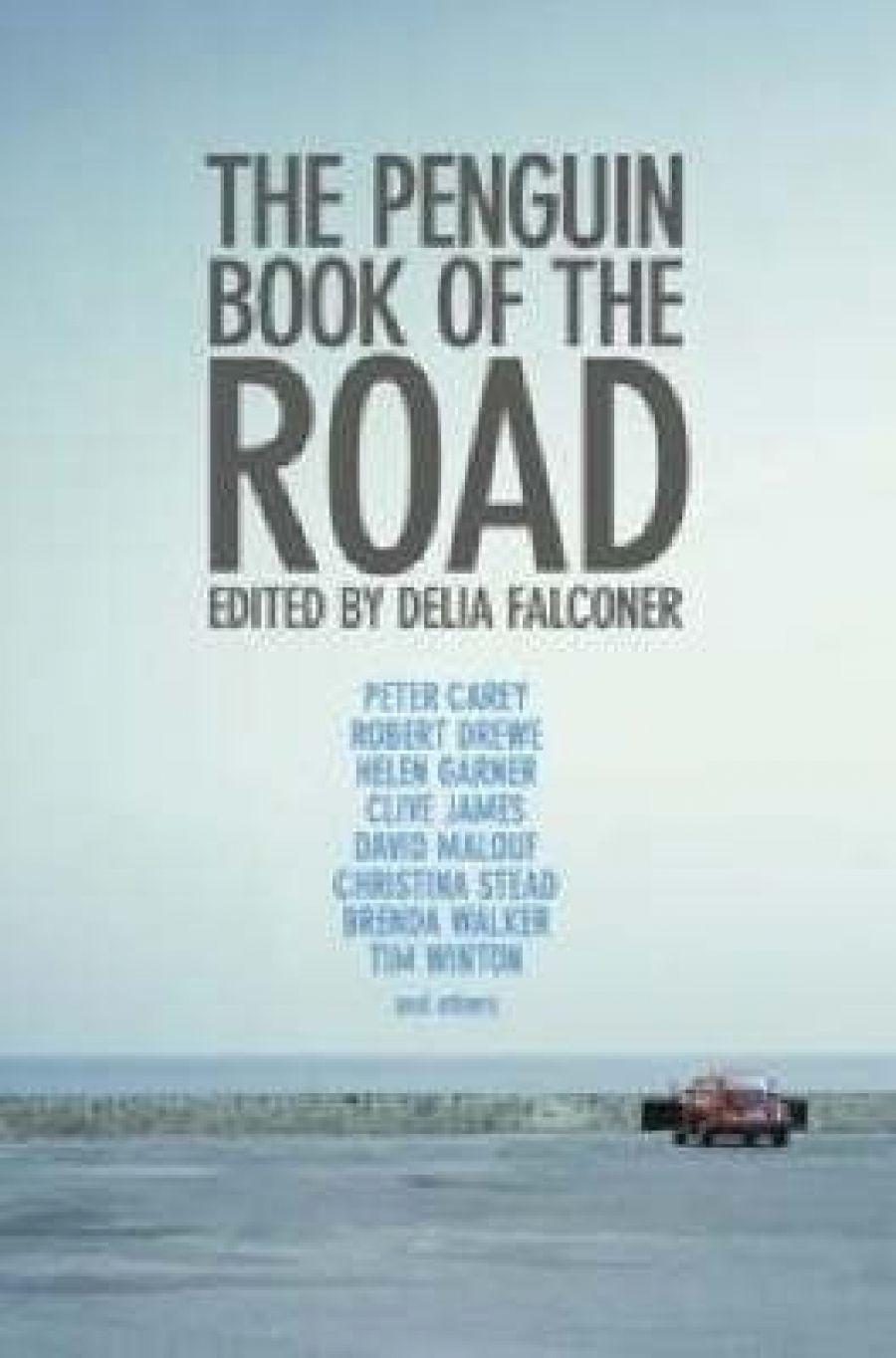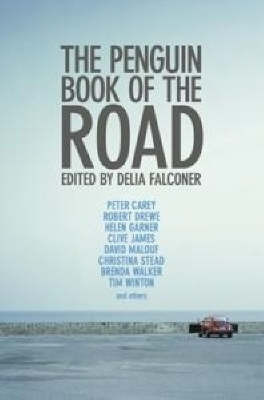
- Free Article: No
- Contents Category: Literary Studies
- Review Article: Yes
- Article Title: The great nothingness
- Online Only: No
- Custom Highlight Text:
Roads are not places, but ways to and away from them, perhaps in fearful flight or in buoyant expectation. Travelling them can engender boredom (‘Are we there yet?’) and horror (‘Will we ever get there, alive?’). Roads are means of reaching those fabled and amorphous Australian locations – the city, the bush, the beach. Each of these has attracted anthologies (some from Penguin). Delia Falconer’s task, as editor of The Penguin Book of the Road, is less straightforward, being concerned with how we travel rather than where we arrive, with highways but also with indirect, crooked ways. In a masterly and challenging introduction, she warns us of what to expect.
- Book 1 Title: The Penguin Book of the Road
- Book 1 Biblio: Viking, $35 pb, 385 pp
- Book 1 Cover Small (400 x 600):

- Book 1 Cover (800 x 1200):

First, the obvious comparison is made. Australia has ‘no homegrown Whitman or Kerouac to sing the freedom of the open road’. Instead, Falconer contends, we celebrate the ‘strangeness’ of our roads, with their ‘Big Pineapples, desert hermits and marauding hoons’. Further, ‘while the American road speeds forward, Australian tracks wind back’. Instead of a journey into an uncertain, perhaps exciting future, Australians by this reckoning seek ways to return home. Or sometimes they do. Falconer’s allusion is to ‘Along the Road to Gundagai’, although she might have remarked that Jack O’Hagan changed the place name when he could not sell the ditty originally called ‘Down Carolina Way’.
Convicts believed (or pretended to) that a fabled track would lead them to freedom in China. Meanwhile, European settlers constructed roads that were means of erasure, as well as connection, ‘implacable replacements for storied indigenous paths’. When once Australian roads were thronged by Cooee marchers on their way to enlistment in the Great War, later by the desperate and unemployed during the Depression, then in the 1960s by the Freedom Riders (mimicking American road crusades) in search of Aboriginal rights, now they facilitate the travel of ‘grey nomads, back-packers and jaded city-dwellers’. For these latter, the possibility of movement is more important than the temporary destinations to which the roads might take them.
A couple of nomads perish horribly in David Malouf’s story ‘Lone Pine’ (one of the twenty-nine pieces that Falconer collects, including extracts from larger works). Falconer provides ample witness to the predators who stalk Australian roads, fictional counterparts of Ivan Milat and Bradley John Murdoch, who ensure that the road can be a ribbon of terror. Roads, besides their many other functions, lead Australian travellers through a country of unmarked graves. And, as the dying anthropologist Carl Strehlow comes to understand, in ‘Journey to Horseshoe Bend’, a memoir by his son, ‘God doesn’t help’.
The Penguin Book of the Road begins with a near-death experience, when art critic Robert Hughes, with a freshly caught bluefin tuna in his boot, is involved in a head-on crash in the Kimberley: ‘I just drove off the edge of the world.’ Following this is another Western Australian story, dictated by Robert Bropho, of ‘The Great Journey of the Aboriginal Teenagers’. Resourcefully but only for a short time, they escape their desolate lives – ‘It was idleness then for us’ – to go on the road, in stolen cars, hunted, but briefly free. Patrick West’s ‘Nhill’ relates a more leisurely excursion, to a salt lake near the Victorian town. Its resonant name speaks to an essential Australian disposition – towards nihilism – which Falconer addresses when she speaks of ‘the great nothingness that thrills at the edges of our road stories’.
Next we move back into the nineteenth century, to ‘The Search for Mr Cunningham’, an extract from the journals of the explorer Major Thomas Mitchell. The order of pieces in Falconer’s anthology is full of artful but unobtrusive juxtapositions and continuations. Chronology is eschewed. Instead, we have the rare pleasure of reading through, rather than sampling, a book that is greater than its parts, that becomes an unsettling way of reading the country. For Mitchell, ‘the occasional absence of this gentleman was not uncommon’, and Cunningham ought to have been able to follow the wagon tracks of the expedition, for they ‘looked like a road that had been used for years’. Cunningham has vanished; Mitchell is baffled. An explorer’s momentum is forwards, but now he must criss-cross, despairingly, as if in a maze.
In a mini-sequence within the whole, one that exemplifies Falconer’s control of her material and her sense of the possibilities of leading us through shifts of tone and variety of incident, Gillian Mears’s chilling story ‘The Burial and the Busker’ is followed by Clive James’s comic account of a different sort of adolescent misadventure, ‘Billycart Hill’. Mears begins with the obliterating power of roads: ‘part of the new highway will soon run over the remains of eighteen bodies. My best friend is under the shiniest headstone.’ James’s piece is succeeded by the lurid night terrors of Barbara Baynton’s ‘A Dreamer’, in which a woman, abandoned, must choose between two roads home. Then comes the longest and one of the most surprising of Falconer’s choices for the book, William Hay’s ‘An Australian Rip Van Winkle’.
Hay, perhaps the most notable Australian author to die while fighting a bushfire, muses on ‘those neat little roads leading so persistently whereby all human conjecture there is nothing, and never was anything’. Beyond daylight or the courage of wanderers, as Hay has it, these roads ‘[thread] unfalteringly into the unknown’. From his journey, the eponymous hero, also known as Jake the Stockman, returns looking as if ‘he had been dug up from a grave’. We remain in the realm of nightmare, although now in the present time, with Tara June Winch’s ‘Territory’, and in the episode from the first volume of Roberta Sykes’s autobiographical trilogy, which is bleakly titled ‘Seventeenth Birthday’.
Set against these stories is the rough and resilient humour of Dorothy Hewett’s ‘Nullarbor Honeymoon’. When finally the brawling couple reach Perth, they ‘are like the dust bowl Joads [in John Steinbeck’s Depression novel, The Grapes of Wrath] gazing down on the California orange groves’. Linda Jaivin’s road story concerns a no doubt politically offensive zipless fuck between a truckie and a lecturer in women’s studies, of which the latter boasts, by letter, to a girlfriend. This exaggeratedly unsentimental story is called ‘The Road to Gundagai’. As Tim Winton takes us tracking ‘North’, with his character hitching up the Great Northern Highway, places along the way become forbidding metaphors, as when the truck nears the Opthalmia Ranges. Although The Penguin Book of the Road ends upbeat, with Helen Garner’s ‘A Happy Story’, it seems as if Falconer has placed it as a wishful coda, a way of giving thanks for what can survive our road journeys, and the personal and national metaphors for which they stand.


Comments powered by CComment